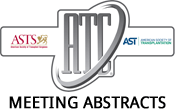2015 American Transplant Congress
Sensitization Level at Retransplant Among Non-Sensitized Pediatric Recipients of First Deceased Donor Kidney Transplants Not Affected by DR Mismatch Level
Background. Most pediatric (ped) kidney (KI) recipients (recips) received 1- or 2-DR HLA mistmached (MM) deceased donor (DD) kidneys. The degree of HLA MM between…2015 American Transplant Congress
Investigation of Myocardial Function in Pediatric Transplant Recipients
Children's National, Washington, DC.
Purpose: In light of the major impact of cardiovascular morbidity on long-term transplant outcomes, a prospective controlled study was conducted to investigate changes in myocardial…2015 American Transplant Congress
Longitudinal Follow-Up of Cardiovascular Comorbidity in Pediatric Renal Transplant Recipients – Results from the 4C-T Study
Purpose: Children with chronic kidney disease (CKD) carry an increased cardiovascular risk. Cardiovascular death is the second leading cause of death in children after renal…2015 American Transplant Congress
Long-Term Efficacy and Safety of an EVR- Vs. an MMF-Based Regimen After Pediatric Kidney Transplantation (KTX): A Case-Control Study Within the CERTAIN Registry
Background: Only short-term trials using everolimus (EVR) in children after KTX have been published. Hereby we present 4 year data on low-dose ciclosporin A (CsA),…2015 American Transplant Congress
Steroid Free Immunosuppression Protocol in Pediatric Kidney Transplant Recipients Using Alemtuzumab: A Retrospective Single Center Study
Background: Steroid free immunosuppression is attractive in pediatric kidney transplantation (KTx). Aim of the present study is to examine the patient survival, graft survival, rate…2015 American Transplant Congress
Activated T Regulatory Cells Escape Death by Increasing Cytoplasmic Serine Protease Inhibitor 6 (SPI6)
Renal/ Transplantation Research Center, Brigham and Women's Hospital, Boston, MA.
Regulatory T cells (Tregs) can employ a granzyme B (GrB)-dependent mechanism to mediate suppression of effector cells by inducing their apoptosis. In this study we…2015 American Transplant Congress
Stimulating Protease Inhibitor 9 Expression By Human Regulatory T Cells Improve Homeostasis
Renal/ Transplantation Research Center, Brigham and Women's Hospital, Boston, MA.
In this study, we show for the first time the key role of a protease inhibitor PI9 in human regulatory T cells (Tregs) homeostasis. Recent…2015 American Transplant Congress
Ex Vivo Expansion With Rapamycin Enhances the Suppressive Function of Regulatory T Cells (Tregs) Isolated from Pediatric Thymus
INTRODUCTION: Treg-based cellular therapy to suppress graft-directed immunity could reduce the need for life-long immunosuppressive drugs. Challenges include isolation and expansion of pure Tregs to…2015 American Transplant Congress
Generation, Cryopreservation, Function and In Vivo Fate of Ex-Vivo Expanded Cynomolgus
Background:Foxp3+ regulatory T cells (Treg) function to promote immune tolerance and prevent immunopathogenesis. Preclinical studies have demonstrated that adoptive transfer of Treg prevents rejection of…2015 American Transplant Congress
In Vivo Expansion of Donor-Specific Regulatory T Cells by a New Triazolopyrimidine Derivative and Donor-Specific Transfusion
Background: We have previously demonstrated that a new triazolopyrimidine derivative, NK026680 (NK) prevents activation/maturation of dendritic cells. This study investigated whether NK together with donor-specific…
